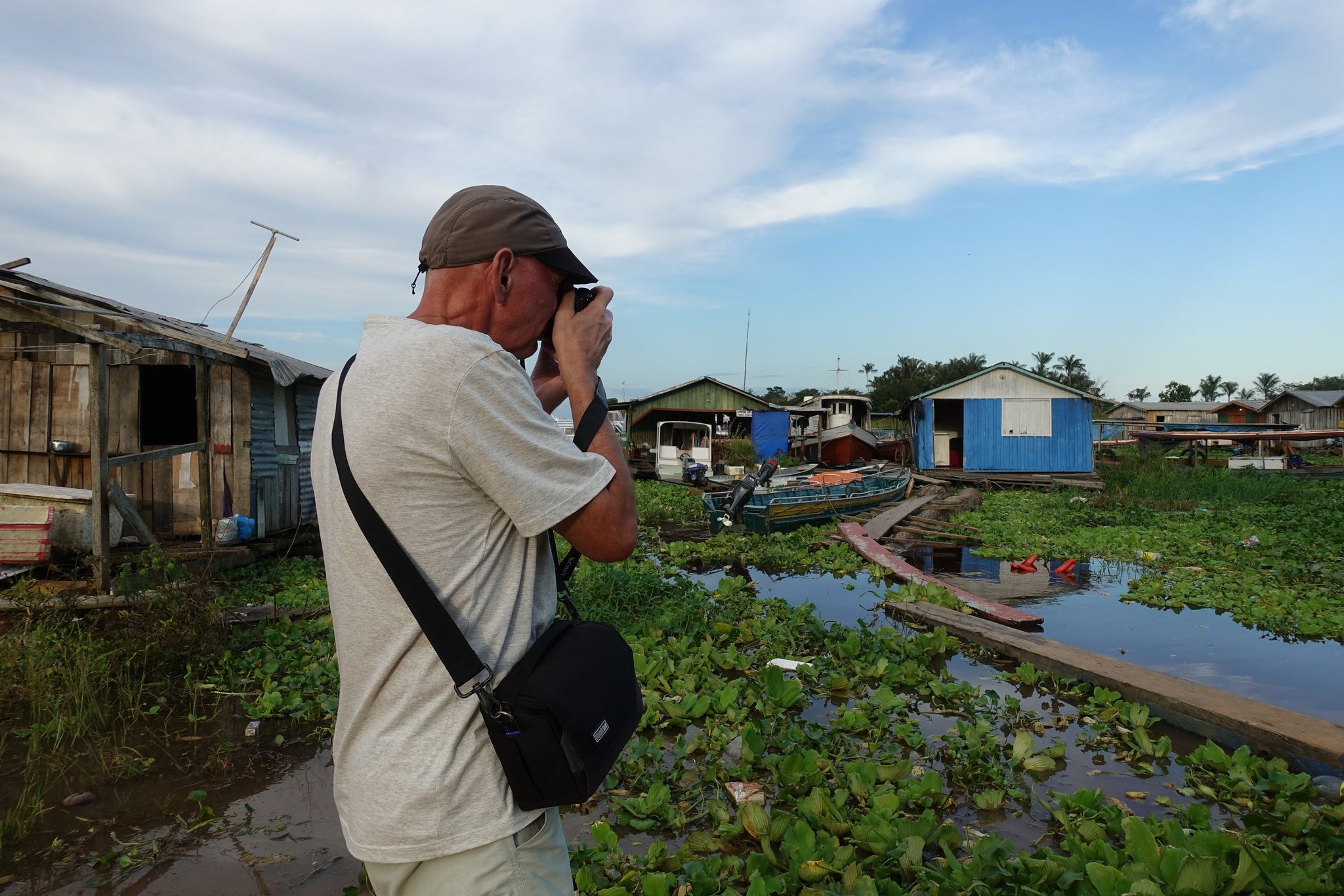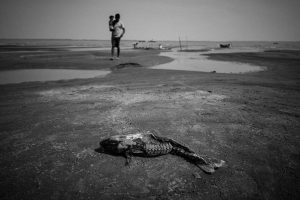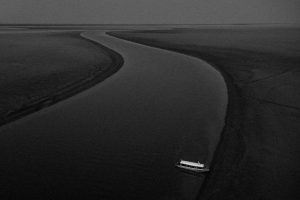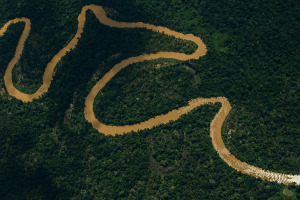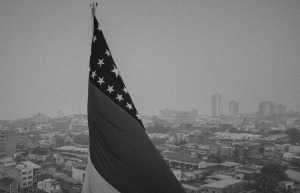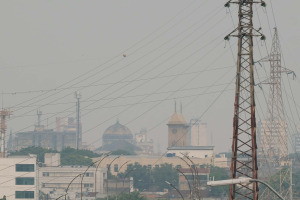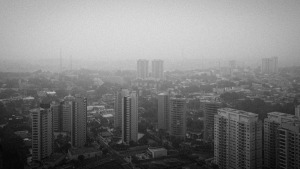C. Cornell Evers in Amazonas (Foto © Ivan Cámara)
![]()
fOCUS AMAZÔNIA

Droogte in Solimões Rivier © Raphael Alves Brazilië kampt met ernstige droogte, hittegolven en bosbranden die het Amazonegebied en de Pantanal verwoesten. Rook bedekt steden, waardoor de luchtkwaliteit gevaarlijk is. Het Amazonegebied, ‘de groene long van onze planeet’, staat voor een ongekende uitdaging. De Rio Negro, een van de belangrijkste rivieren in het gebied, heeft een historisch dieptepunt bereikt. In 122 jaar van metingen is het water nog nooit zo laag geweest. Dit heeft verstrekkende gevolgen voor zowel mens als natuur. Talloze dorpen en steden in de regio zijn nu geïsoleerd door het lage waterpeil. De gevolgen voor de lokale fauna zijn schrijnend zichtbaar: massale vissterfte en dode dolfijnen zijn slechts enkele voorbeelden van de ecologische ramp die zich voltrekt. Bovendien worstelt het regenwoud om zijn cruciale functie als koolstofopslag te behouden. De crisis beperkt zich niet tot het Amazonegebied alleen. Ook de Paraguay-rivier in het Pantanal-wetland staat op een ongekend laag niveau. De Cerrado-savanne kampt eveneens met extreme droogte. Deze situatie stelt de Braziliaanse ecosystemen voor uitdagingen die nog niet eerder zijn gezien. In Manaus, de hoofdstad van de staat Amazonas, bereikte de Rio Negro op 4 oktober 2024 een nieuw diepterecord van 12,66 meter. Dit is nog lager dan het vorige record uit oktober 2023. Experts verwachten dat het water nog verder kan zakken voordat het regenseizoen aanbreekt. Klimaatverandering en extreme weersomstandigheden Het Amazonegebied, met zijn ongeëvenaarde biodiversiteit en cruciale rol in de mondiale koolstofcyclus, wordt steeds harder getroffen door klimaatverandering. De combinatie van ontbossing en opwarming van de aarde leidt tot een droger Amazonegebied. Dit brengt het risico met zich mee van grootschalige boomsterfte, wat op zijn beurt weer kan leiden tot een enorme uitstoot van CO2. De afgelopen jaren hebben een verontrustend patroon laten zien van afwisselend extreme overstromingen en ernstige droogtes. Deze toenemende onvoorspelbaarheid van het klimaat vormt een grote bedreiging voor zowel de lokale ecosystemen als de gemeenschappen die afhankelijk zijn van het Amazonegebied. fOCUS Amazônia La casa de Cristiane Cristiane’s house Foto’s © Raphael Alves #manaus #amazonas #amazonia #rionegro #drought #climatechange Banzeiro is de rockende golfslag van een boot of kano op de Amazone. Banzeiro is een website die aandacht vraagt voor de Amazone als belangrijk klimaatcontrolecentrum van de wereld. De redactie van Banzeiro is volledig onafhankelijk en vrij van commerciële belangen. Het team wordt niet beïnvloed door derde partijen en laat zich niet leiden door externe meningen. Hierdoor kunnen zij een stem geven aan diegenen die niet gehoord worden, met name de bewoners van de Amazone. Feitelijke informatie staat centraal bij Banzeiro. In een tijd waarin het steeds lastiger wordt om waarheid van onwaarheid te onderscheiden, blijft Banzeiro zijn lezers voorzien van het echte verhaal.

A boat sits in the shallow waters of Lago Grande, one of the areas most affected by the extreme drought in the Amazon Basin. This image was taken in Manacapuru, Amazonas, Brazil. The 2023 drought was the worst ever recorded in the state of Amazonas. The drought affected all of the state’s municipalities in terms of services, transportation, and supply because rivers are the main route in Brazil’s largest state. All of the state’s cities were built around the rivers of the Amazon basin. Quando as águas/When the Waters Words & Images Raphael Alves Translation C. Cornell Evers Quando as águas/When the Waters is a photographic project that seeks to explore the relationship between man and the water cycle in the Amazon. These issues are addressed in the context of the eternal dichotomy of ebb (vazante) and flow (enchente) that sustains the continuity of life in the water and to which the Amazonian people have historically had to adapt. In addition, Quando as águas/When the Waters proposes a debate on the evident effects of climate change around the world, which have a direct impact on events related to the water cycle in this region: episodes of extreme flooding and devastating droughts are becoming more frequent. As a parameter to assess the intensity with which the phenomena are occurring, it is enough to point out that the record of the water level of the Rio Negro during a flood period was broken for the first time after 56 years, since the river began to be ‘measured’ (in 1902): it reached 29.69 meters in 1953 and 29.71 in 2009. That year, the rising waters caused many problems, especially in Manaus (the largest city in the Amazon), such as the flooding of riverside communities; the diversion of traffic, as several streets were flooded; commercial losses, as shops were submerged; and the spread of disease, as the flooding period caused the sewage system in the central region of the city to overflow. Many people thought that such an extreme event would not happen again for another half century. They were wrong. In 2012, the level of the Negro reached 29.97 meters, and all the problems of the 2009 flood came back stronger as Manaus grew more and more. In 2013, the flood reached 29.33 meters. Although it didn’t break the records of 2012 and 2009, the 2013 flood is one of the most intense ever recorded. In 2021, the Negro reached a new record: 30.02m. It was the biggest flood the Amazon basin has ever seen. Droughts are also becoming more frequent. On the Negro River, the first record drought in 1964 (when the water level dropped to 13.64 meters) was surpassed only in 2010 (by one centimeter, when the water level dropped to 13.63 meters). The worst was yet to come. In 2023, two years after a major flood, the Amazon Basin experienced the largest and most severe drought in its history. All 62 municipalities in Amazonas went into a state of emergency. The Quando as águas/When the Waters project has witnessed these limits being pushed further and further to the extreme. A woman carries a bottle to fetch water from the Solimões riverbed (in the rural village of Pesqueiro II, in Manacapuru, Amazonas, Brazil), which was affected by the 2012 drought. Residents of riverine areas like this one are forced to walk dozens of kilometers with bottles or buckets in search of water during periods of severe drought. A floating house is seen stranded on the Tarumã Açu River, one of the main tributaries of the Rio Negro, in Manaus, Amazonas, Brazil. The Rio Negro, the largest tributary on the lower reaches of the Amazon River, reached 13.59 m on this day (October 16, 2023), marking the most severe drought in the Rio Negro’s history. The Amazon experienced the worst drought in its history, isolating communities, disrupting navigation, and dramatically reducing the distribution of products. A collapsed and abandoned house is seen in the flooded streets of Anamã, Amazonas, Brazil, on May 25, 2021, during the largest flood ever recorded in the Amazon basin. Anamã has been an “amphibious city” for years. Many families are forced to leave their homes for at least three months, some forever. A boy carries a tucunaré he won at a fair to his floating house (located in the village of Cacau Pirêra, on the banks of the Rio Negro, Amazonas, Brazil), which was cut off due to drought in 2012. Families living along the river usually fish for their own consumption, but the dry season forces them to look for alternatives. Boatman Paulo Monteiro da Cruz, 49, navigates among tens of thousands of fish killed by the heat and acidity of the water in the Lago do Piranha Sustainable Development Reserve, in Manacapuru, Amazonas, Brazil, in September 2023. The 62 municipalities of the state of Amazonas were affected by the worst drought in the history of the Amazon basin. Over 600,000 people were affected. This was the most intense drought in the history of the state of Amazonas. People living near the Igarapé 40, one of Manaus’ main waterways, lived with large amounts of garbage, sewage, and vermin during the heavy flooding of 2009, one of the largest floods ever recorded on the Rio Negro. Manaus’ urban rivers are unsuitable for any use due to the inefficient sewage system in the capital of Brazil’s largest state. Raimundo Silva do Carmo, 68, gets emotional after collecting water from a well he dug in Lago do Puraquequara, east of Manaus, one of the places in the city most affected by the drought that hit the Amazon in 2023. Raimundo shared his well with other families in the area during this difficult time. The 2023 drought, the longest and most intense drought ever recorded in the Amazon Basin, affected access to water, products and services, and income for many Amazonian families. Farmer Noé Vieira do Carmo, 44, laments the loss of his passion fruit plantation due to the Lees verder >>

Seca no Rio Branco Drought on the Branco River Roraima Seca no Rio Branco – Drought on the Branco River – Roraima A series by photographer © Raphael Alves More extreme weather in the Amazon Scientists have been predicting for years that climate change will lead to increased rainfall and droughts around the world. Unfortunately, the climate problem has rapidly worsened and is now affecting daily life in the Amazon, where extreme weather conditions have led to longer droughts and periods of severe flooding. The haunting images of deforestation, biomass burning, and the suffering of Amazonian peoples captured by photographers such as Raphael Alves, Bruno Kelly, Alberto César Araújo, and others evoke the ancient apocalyptic prophecy of Bob Dylan’s 1962 A Hard Rain’s A-Gonna Fall: “I saw a black branch with blood that kept drippin’.” From the same song also comes the line, “I’ve stepped in the middle of seven sad forests.” As if the singer foresaw what would become of the rainforests near the hydroelectric dams that successive Brazilian governments, driven by a thirst for power and, as we now know, bribes, have built in the Amazon. In the Brazilian Amazon, the state of Acre is currently experiencing severe flooding. Meanwhile, the state of Roraima is still dealing with the aftermath of a historic drought that recently nearly dried up the Rio Branco riverbed near the capital, Boa Vista. Follow the level of the Rio Branco here: Companhia de Águas e Esgotos de Roraima

Photography © Raphael Alves When the river of my childhood runs dry/Quando secar o rio da minha infância by Raphael Alves, January 20, 2024 The drought that occurs every year in the Amazon region has this time left Brazil’s largest state (Amazonas) and most of the Amazon in a state of emergency. The 62 municipalities have suffered from the drought, affecting the lives of more than 600,000 people. All this, two years after the biggest flood in history. In other words, extreme events are becoming more frequent due to climate change and the impact of unbridled human activity. The damage was felt by the inhabitants of the Amazon region. High temperatures, sandbanks that formed in the middle of rivers, isolating communities and riverine settlements. This year’s drought reached the historic mark of 12.70 meters, according to a record made at the port of Manaus on October 27, the lowest level since measurements began 121 years ago. According to the National Center for Natural Disaster Monitoring and Warning, rainfall from June to August was below average for the period. Experts point out that two main factors inhibited the formation of clouds and, consequently, rainfall: the El Niño phenomenon, characterized by an abnormal warming of the Pacific Ocean, and climate change. Raphael Alves’ series When the river of my childhood runs dry/Quando secar o rio da minha infância is his entry for the Photo Essay (Ensaio) category of the 2024 FOTODOC PORTFOLIO AWARD, a platform for publishing the work of Brazilian and foreign photographers, with annual prizes. Organized by FotoDoc – Festival of Documentary Photography, the aim of the competition is to give visibility to the most diverse forms of photographic expression, without restriction of theme or approach, always seeking excellence in form and content. Born in Manaus (Amazonas, Brazil), Raphael Alves studied Social Communication with a major in Journalism at the Federal University of Amazonas (UFAM), Photography at the State University of Londrina (UEL) and Visual Arts at the National Commercial Education Service (SENAC). He also holds a Master of Arts degree in Photojournalism and Documentary Photography from the London College of Communication / University of the Arts, in London (ING). Raphael’s work has won Pictures of the Year Latin America – POYLatam (2017 and 2021) and Pictures of the Year International POYi (2022), as well as the Getty Images Editorial Grant (2021). In 2023, his work won The Nature Conservancy Contest.

Manaus (AM) – Raphael Alves, an award-winning photographer and journalist from Amazonas, has received an honorable mention in the documentary category of the Sony World Photography Awards 2024, one of the world’s most prestigious photography competitions. His photo story, The Falling Sky/A Queda do Céu, created for the Spanish news agency EFE, highlights the humanitarian crisis in the indigenous Yanomami land of Roraima in the Brazilian Amazon. The photographs will be exhibited at the Sony World Photography Awards 2024 exhibition at the Somerset House Gallery in London, United Kingdom, from April 19 to May 6. The Yanomami indigenous territory covers parts of the Brazilian states of Roraima and Amazonas and is plagued by illegal mining, malaria and malnutrition. In January 2023, indigenous and environmental organizations denounced an ongoing humanitarian tragedy in the area. Raphael Alves had been following reports of hunger, disease, and illegal mining plaguing the Yanomami for some time. In 2023, he traveled to the Yanomami territory to document for himself what was happening. Although he was unable to visit the affected villages, he was able to photograph along the miners’ routes and witness the devastation from the air. He also documented the rescue of Yanomami children in Boa Vista, the capital of Roraima. The humanitarian tragedy he witnessed left him deeply sickened. “It is difficult to find the right words to explain what is happening. It is heartbreaking to see how greed destroys culture, history and lives. As human beings, we can only rebel against such injustice. Raphael Alves emphasizes that taking the photographs made him realize how the Yanomami and the Amazon are ignored by government policies, authorities and the mainstream media. He hopes that the exhibition will draw the world’s attention to the plight of these people. The award-winning series is called The Falling Sky/A Queda do Céu, after the 2013 book of the same name by shaman Davi Kopenawa and anthropologist Bruce Albert. “When all the shamans have died, I think the sky will fall. (…) The forest will be destroyed and the weather will be dark. If there are no more shamans to hold up the sky, it will not stay up. Although the white people are clever, they ignore shamanism, they are not the ones who can hold up the sky (…) Not only the Yanomami will die, but all the white people will die. No one will escape the fall of the sky.” David Kopenawa, shaman and leader of the Yanomami people of the Amazon rainforest. Sources: Amazonia Real (Nicoly Ambrosio), World Photography Organization The Falling Sky/A Queda do Céu BOA VISTA (BRAZIL), 01/29/2023 – A Yanomami woman with severe malaria and signs of malnutrition receives help after arriving by plane at an airport in the city of Boa Vista, capital of Roraima, Brazil. The government has declared a health emergency for the Yanomami. EFE/ Raphael Alves BOA VISTA (BRAZIL), 30/01/2023 – Movement of the indigenous Yanomami people in front of the field hospital installed by the Brazilian Air Force at the Casa de Saúde Indígena Yanomamim (CASAI Yanomami). EFE/ Raphael Alves BOA VISTA (BRAZIL), 02/02/2023 – The Mucajaí River can be seen with a strong color due to the presence of illegal mining during a mission by the Brazilian Air Force to deliver supplies to the Yanomami people living on indigenous lands near the Surucucu military base, in the Amazonian state of Roraima, Brazil. The mission departed from the state’s capital, Boa Vista, aboard an Embraer KC-390 cargo plane. The Yanomami are experiencing a humanitarian crisis due to the presence of illegal mining on their land. EFE/ Raphael Alves BOA VISTA (BRAZIL), 02/02/2023 – An indigenous hut (shabono*) is seen during a Brazilian Air Force mission to deliver supplies to the Yanomami people living in the indigenous land near the Surucucu military base, in the Amazonian state of Roraima, Brazil. The mission took off from the state capital, Boa Vista, aboard an Embraer KC-390 cargo plane. The Yanomami are experiencing a humanitarian crisis due to the presence of illegal mining on their land. EFE/ Raphael Alves BOA VISTA (BRAZIL), 03/02/23 – A health worker from the Brazilian Air Force (FAB) holds a Yanomami child outside the field hospital set up by the FAB at the Casa de Saúde Indígena Yanomami (Casai Yanomami) in Boa Vista, capital of the Amazonian state of Roraima, Brazil. The Yanomami are experiencing a humanitarian crisis due to the heavy presence of illegal miners on their land. EFE/ Raphael Alves ALTO ALEGRE (BRAZIL), 07/02/2023 – An airplane pilot involved in illegal mining shows seven grams of gold he received as payment for his services in removing garimpeiros from Yanomami indigenous land in the Amazonian state of Roraima, Brazil. Miners are abandoning Yanomami indigenous land in fear of an imminent operation by environmental authorities and police forces in the mines, which has caused a health crisis in the Yanomami territory. EFE / Raphael Alves ALTO ALEGRE (BRAZIL), 07/02/2023) – Undocumented miners leaving the Yanomami indigenous land, in the Amazonian state of Roraima, Brazil, walk under the sun and among the forests, near the port of Arame, Vila do Paredão, in the city of Alto Alegre. This region has received a large influx of miners. They arrive in boats on the Uraricoera River, camp in Porto do Arame and leave in vans – which they pay for in gold or money – or walk for hours in the sun or rain, in the middle of the forest, even reaching the RR-205 if they cannot afford it. The miners are leaving the Yanomami’s land for fear of an imminent operation by environmental authorities and police forces in the mines, which has caused a health crisis in the Yanomami’s territory. EFE / Raphael Alves ALTO ALEGRE (BRAZIL), 07/02/2023 — Illegal miners are seen in the back of a pickup truck as others try to repair a makeshift wooden bridge over a stream in the Porto do Arame region, Vila do Paredão, in the city of Alto Alegre, Roraima, Brazil. This Lees verder >>

Beeld uit de serie The Falling Sky/A Queda do Céu (Foto: Raphael Alves/EFE). Manaus (AM) – Raphael Alves, een bekroonde fotograaf en journalist uit Amazonas, heeft een eervolle vermelding ontvangen in de categorie documentaire van de Sony World Photography Awards 2024, een van ’s werelds meest prestigieuze fotografiewedstrijden. Zijn fotoverhaal, The Falling Sky/A Queda do Céu, gemaakt voor het Spaanse persbureau EFE, belicht de humanitaire crisis in het inheemse land van de Yanomami in Roraima, in het Braziliaanse Amazonegebied. De foto’s zullen tentoongesteld worden tijdens de Sony World Photography Awards 2024 Exhibition in de Somerset House galerie in Londen, Verenigd Koninkrijk, van 19 april tot 6 mei. Het inheemse gebied van de Yanomami beslaat delen van de staten Roraima en Amazonas in Brazilië en wordt geteisterd door illegale mijnbouw, malaria en ondervoeding. In januari 2023 stelden inheemse en milieuorganisaties een aanhoudende humanitaire tragedie in het gebied aan de kaak. Raphael Alves volgde al een tijdje de berichten over de honger, ziekte en illegale mijnbouw die de Yanomami-bevolking teisteren. In 2023 reisde hij af naar het inheemse gebied van de Yanomami om zelf te kunnen documenteren wat er daar gebeurde. Hoewel het hem niet lukte naar de getroffen dorpen zelf te gaan, slaagde hij erin om langs de routes van de mijnwerkers te fotograferen en vanuit de lucht de verwoesting te aanschouwen. De fotograaf vertelde persbureau Amazônia Real uit Manaus dat hij door de taalbarrière en andere obstakels niet naar het inheemse gebied kon, maar dat hij elke dag bleef zoeken naar “iets nieuws, iets dat zou helpen om alles wat daar gebeurde te begrijpen, met behoud van respect, natuurlijk”. Hij documenteerde ook de redding van Yanomami-kinderen in Boa Vista, hoofdstad van Roraima. Bij het zien van de humanitaire tragedie voelde hij diepe walging. “Het is moeilijk om de juiste woorden te vinden om uit te leggen wat er aan de hand is. Het is hartverscheurend om te zien hoe hebzucht cultuur, geschiedenis en levens verwoest. Als mens kunnen we alleen maar in opstand komen tegen zulke onrechtvaardigheid.” Raphael Alves benadrukt dat hij door het maken van de foto’s zich realiseerde hoe de Yanomami en het Amazonegebied worden genegeerd door het overheidsbeleid, de autoriteiten en de mainstream media. Hij hoopt dat de tentoonstelling de aandacht van de wereld vestigt op de situatie van deze mensen. De bekroonde serie draagt de titel The Falling Sky/A Queda do Céu, naar het gelijknamige boek uit 2013 van sjamaan Davi Kopenawa en antropoloog Bruce Albert. “Als alle sjamanen zijn gestorven, denk ik dat de hemel zal vallen. (…) Het bos zal worden vernietigd en het weer zal donker zijn. Als er geen sjamanen meer zijn om de hemel omhoog te houden, zal hij niet op zijn plaats blijven. De witte mensen zijn weliswaar ingenieus, maar ze negeren sjamanisme, zij zijn niet degene die de hemel kunnen ondersteunen (…) Niet alleen de Yanomami gaan sterven, maar ook alle witte mensen. Niemand zal ontsnappen aan de val van de hemel.” David Kopenawa, sjamaan en leider van het Yanomami-volk in het Amazone regenwoud. Raphael Alves: “Davi Kopenawa heeft ons gewaarschuwd voor ‘de val van de hemel’. Wat hij zei over de kennis van niet-bosbewoners die niets kunnen doen aan de gevolgen van het vernietigen van het bos, is al aan de gang. Geen technologie of geld kan de gevolgen van klimaatverandering voorkomen. Geen fortuin kan levens redden van de vergiftiging van lucht en water. Geen enkele uitvinding van het ongebreidelde, roofzuchtige kapitalisme kan de levens terugbrengen van hen die er niet meer zijn. De foto’s die ik genomen heb tonen slechts enkele gevolgen van deze vernietiging, die haar sporen al over de hele wereld heeft achtergelaten.” Tijdens zijn verblijf in Roraima heeft hij geprobeerd om de Yanomami-kwestie te bestuderen en te begrijpen, zodat zijn beelden op een respectvolle manier zouden spreken en de waardigheid van de betrokken mensen behouden zou blijven. Hij zegt dat elke foto die hij maakt een vraag is die hij zichzelf stelt. Hoewel hij naar eigen zeggen geen expert is op de onderwerpen die hij fotografeert, heeft hij er wel onderzoek naar gedaan. Fotografen zien en voelen de aanwezigheid van problemen, beklemtoont hij, en hij hoopt dat zijn werk uiteindelijke anderen zal uitnodigen om vragen te stellen. Serie The Falling Sky/A Queda do Céu (Foto’s: Raphael Alves/EFE). ———————————————————————————————————————— Raphael Alves, afkomstig uit Manaus, heeft Sociale Communicatie gestudeerd met als specialisatie Journalistiek aan de Federale Universiteit van Amazonas (UFAM), Fotografie aan de Staatsuniversiteit van Londrina (UEL) en Beeldende Kunsten aan de Nationale Dienst voor Commerciële Leergangen (SENAC). Daarnaast heeft hij een Master of Arts in fotojournalistiek en documentaire fotografie behaald aan het London College of Communication/ University of the Arts in Londen, Engeland. Hij neemt deel aan Everyday Brasil, een project waarvoor fotografen uit het hele land het dagelijks leven in Brazilië documenteren. Zijn persoonlijke projecten richten zich op het onderzoeken van de relatie tussen de mens en de omgeving waarin natuur en stad samenkomen. Raphael heeft vele prestigieuze prijzen gewonnen, waaronder de eerste plaats in de categorie ‘The Pandemic in Ibero America’ bij Pictures of the Year Latin America (POY Latam) in 2021 voor zijn reportage over Covid-19 in Manaus. In 2021 ontving hij een eervolle vermelding bij de Siena Photo Awards, won hij de XXVII Latin American Documentary Photography Competition en ontving hij de Getty Images editorial grant. In 2022 werd zijn werk ook erkend bij POY International en ontving hij de derde plaats in de Conrado Wessel Foundation (FCW) Photography Prize. In 2023 was hij een van de winnaars van de BarTur Photo Award. Bronnen:

The early years – In 1990, I survived my first encounter with the Amazon jungle. Manaus, Amazonas, June 1990 The narrow, uneven streets of Manaus are filled with a cacophony of shouts, honking cars, and music. Radios and sound systems blare. Noise is everywhere. The air is hot and humid. The thermometer indicates forty degrees Celsius. We find only one terrace, tucked away on the first floor of a run-down building. Across from it is the Palace of Justice, where the work schedule seems mainly to consist of an eternal siesta of coffee and lunch breaks. At the agreed time, a not too tall but sturdy man approaches our table and introduces himself. His English and blond hair suggest an American in exile. Marco Lima, however, is a true Brazilian. During our conversation, he often mentions the word “respect”, in relation to both the nature and the inhabitants of the forest. He is clearly the guide we are looking for, and we decide to depart the following day. Our destination is the Anavilhanas Archipelago, a large group of islands in the Rio Negro between Manaus and the northern town of Nova Airão. A dockworkers’ strike the next morning proves no hindrance to our preparations for departure. The boat’s crew, aside from Marco, consists of a small boy with indigenous traits, Coruja, and a Creole named José. They both live on the Lajana, as the boat is named. As José steers the Lajana alongside a floating gas station towards open water, Marco provides us with some details about the area we are heading to, about the igapós, the blackwater-flooded forests in the Amazon biome. The clear black water of the Rio Negro is said to be poor, which is why, for example, there are far fewer insects than in the Amazon. Still, about three hundred different species of fish live in the river. Of these, the pirarucu, which can grow more than three meters long, is the largest. Overfishing threatens the survival of this second largest freshwater fish in the world. As our boat steadily progresses, Marco points out the lush vegetation along the water, the air roots hanging down in long strands, the many parasites that grow and spread in the most diverse species on host trees. It is a wonderful sight with trees, each of which, due to the many ‘guests’, forms a capricious botanical garden. After a few hours of sailing, we pass some buildings on the shore, a sort of settlement, with an old-fashioned looking well and stairs carved into the coastal wall leading to the water. A leper colony. This is where the outcasts live. Several hours later, after we have arrived in the area of the islands, we take a small paddle boat on a trip through the flooded forest. Marco points to a large concentration of air bubbles in the water. “Piranhas.” He himself has a few scars from bites, one between his eyes (“the piranha’s kiss”), but argues that it is possible to live with this voracious little fish, as long as you take into account its behavior. There are even periods when the piranha is vegetarian, living off tree fruits that grow close to the water. As evening approaches, we head for a tree standing upright in the middle of the water. Before the boat is secured, we check the branches for snakes. A single lizard is all that moves. It’s already dark. The hammocks are rolled out and hung up. It’s eight o’clock. Just as I fall asleep, I’m woken by the rain clattering on the upper deck. Huge flashes light up the surroundings in a ghostly light. While Marco and the two boys secure tarpaulins and steer the boat closer to the shore, I enjoy an unforgettable spectacle. The next day promises to be beautiful, but it will bring a confrontation that will abruptly end our trip. Chased by the devil In the sky above us, several hawks hover, searching for prey. Chattering parrots flutter like bright green spots between trees, from which the roar of a group of monkeys sometimes echoes. After breakfast, we prepare to go fishing for piranhas in the dense vegetation of the islands with a small paddleboat. It takes some effort to navigate into the forest. A floating log occasionally obstructs our path. We have to use all our strength to pull the boat over it. In a relatively open spot, we bang the water with sticks that serve as fishing rods, to lure the notorious predatory fish. When the creatures haven’t bitten after ten minutes, we decide to sail a bit further. While Marco steers the boat with the paddle through the forest, I open my camera to change the film. A sweet smell enters my nostrils, and suddenly I sense a pervasive hum near my ears and feel something crawling on my head. A sting and another, and I drop the film and camera into the water. For a moment, I think I’m the only one being attacked, but then I hear José screaming behind me: “BEES!” The pests are everywhere, in our hair and our clothes. My shirt seems to be on fire. I flail wildly around me. I look back and see José in the water. “Piranhas,” it flashes through my mind. “Caimans.” “On board,” Marco yells to José. He struggles to get out of the water. His leg is bleeding. After several futile attempts to start the outboard engine, it finally roars to life. We blaze our way through the dense vegetation as if the devil himself is on our tail, in the guise of a dark cloud of stinging insects with a singular goal. When the forest spits us out onto the open river, the bees leave us alone. The boat’s floor is strewn with small brown bodies, smacked dead, drowned. A severe attack, according to Marco, but we should still be grateful it wasn’t white bees. José, however, looks incredibly glum. In contrast to the thirty, forty Lees verder >>

Hoofdstad Amazonas onder rook bosbranden (Foto © Raphael Alves) De droogte van 2023 in het Amazonegebied is een duidelijke manifestatie van de klimaatcrisis. De tendens is dat de effecten nog zullen verergeren, zowel tijdens de huidige gebeurtenis als in de toekomst in termen van frequentie en intensiteit. Experts schrijven de langdurige droogte en buitengewoon lage waterstanden in de rivieren van de Amazone toe aan een combinatie van El Niño en de opwarming van de Noord-Atlantische Oceaan. Deze twee factoren hebben een negatieve invloed op de vorming van wolken en regen. De huidige hevige droogte in het Amazone regenwoud wordt beschouwd als de ergste in meer dan een eeuw, met als complicerende factoren hoge temperaturen, enorme milieuvervuiling en rook. Meteorologen verwachten dat de situatie de komende maanden nog zal verergeren en het begin zal vertragen van het regenseizoen dat gewoonlijk in oktober begint. Philip Martin Fearnside, onderzoeker verbonden aan het Nationaal Instituut voor Amazone Onderzoek (INPA) in Manaus, vergelijkt de droogte van dit jaar met die van 2015 en 2016. Destijds veroorzaakte het El Niño fenomeen vergelijkbare heftige beelden van dieren die stierven in warme, zuurstofarme rivieren. Fearnside waarschuwt echter dat de temperaturen dit keer hoger zijn dan toen, wat ook blijkt uit gegevens van het Nationaal Meteorologisch Instituut (INMET). Momenteel is het oostelijke deel van de equatoriale Stille Oceaan warmer dan tijdens de ‘Godzilla’ El Niño van 2015-2016 (type ‘Oostelijke El Niño’). Deze warme zone breidt zich uit naar het centrale deel van de Stille Oceaan, het gebied dat El Niño’s van het type zoals in 1982-1983 veroorzaakt (‘Centrale El Niño’-type)). Beide El Niño’s hebben invloed op het noordelijke deel van de Amazone. De oostelijke El Niño heeft ook invloed op gebieden in het zuidwesten van de Amazone, zoals in 2015 gebeurde, en dit jaar leidde tot extreem lage waterstanden in de rivieren Madeira en Purus. Tegelijkertijd is er sprake van opwarming van het water in het tropische deel van de Noord-Atlantische Oceaan, wat droogte veroorzaakt in het zuidwesten van de Amazone, zoals eerder in 2005 en 2010. De voorspelling is dat het regenseizoen dit jaar later zal beginnen en droger zal zijn dan normaal, wat niet alleen leidt tot extreme droogte dit jaar, maar ook tot lage waterstanden in 2024. De nog steeds voortdurende droogte van 2023 heeft al ernstige schade veroorzaakt. In het Tefé-meer hebben eind september 153 dolfijnen het leven gelaten, doordat de temperatuur van het water tot ruim 39 graden Celsius steeg, wat thermische stress bij de dieren veroorzaakte. Op veel plaatsen zijn grote aantallen vissen gestorven door de stijging van de watertemperatuur, zowel door het directe effect van de temperatuur als door de daling van het zuurstofgehalte in het water. Het isolement van gemeenschappen, de onmogelijkheid van transport over de rivieren op veel plaatsen en het verlies van middelen voor levensonderhoud, zoals visserij en landbouw, hebben ook dramatische gevolgen voor de bevolking. Als de rook… niet is verdwenen Manaus getroffen door vervuilde lucht bosbranden (Foto’s © Raphael Alves) In het vochtige tropische regenwoud zijn er voor een brand drie voorwaarden nodig: een droog klimaat, veel organisch materiaal dat zich ophoopt op de grond en iemand die een aansteker gebruikt. Tussen juli en oktober is er in het Amazonegebied een droge periode waarin de kans op branden het grootst is, maar zonder de aanwezigheid van de twee andere factoren hoeft de situatie niet uit de hand te lopen. Actuele grafieken van het Braziliaanse Instituut voor Ruimteonderzoek (Inpe) tonen aan dat de ontbossing in de Braziliaanse Amazone in de tweede helft van dit jaar een dalende lijn vertoont. Tegelijkertijd wordt het noorden van het gebied getroffen door de hevigste droogte in meer dan een eeuw. Delen van de Braziliaanse deelstaat Amazonas bevinden zich op dit moment in een noodsituatie. Er zijn meer dan duizend branden ontstaan en rivieren zijn veranderd in woestijnen. De droogte treft zo’n 500.000 inwoners. De rook afkomstig van de bosbranden in het gebied rondom Manaus was tijdelijk afgenomen, maar inmiddels wordt de hoofdstad van de Braziliaanse deelstaat Amazonas opnieuw getroffen door vervuilde lucht. De branden in Pará en het binnenland van Amazonas veroorzaken al dagen rook die richting Manaus waait en door de warmte blijft de rook laag hangen en ademen mensen deze in. Deze keer stroomt de rook van oost naar west door de passaatwinden die vanaf de Braziliaanse kust waaien. “Door de droogte zal de vispopulatie afnemen en kwetsbare soorten dreigen uit te sterven.” Carlos Durigan, geograaf en directeur van WCS Brasil (Wildlife Conservation Association), dringt aan op actie en een verandering van mentaliteit, vooral bij het openbaar bestuur van Amazonas en zijn gemeenten. Hij betreurt het dat mensen in de regio zich nog altijd niet lijken te realiseren hoe ernstig deze extreme periode is. “Veel mensen gaan gewoon door met hun dagelijkse leven alsof er niets aan de hand is, zoals het gebruik van vuur bij landbouwactiviteiten. Het zou fijn zijn als ze meer voorzichtigheid zouden betrachten met het gebruik van vuur, gezien de schadelijke gevolgen voor zowel mensen als de natuur.” Wat het probleem nog erger maakt, is dat het opdrogen van de rivieren een enorme impact zal hebben op de biodiversiteit in het water. Hoewel er nog geen studies of gegevens beschikbaar zijn, verwacht Durigan dat de vispopulatie aanzienlijk zal afnemen en dat veel kwetsbare soorten zelfs dreigen uit te sterven nu verschillende rivieren bijna volledig zijn opgedroogd. Porque arde o chão Porque arde el suelo Why the ground burns BR-319 – Careiro Castanho, Amazonas (Foto’s © Raphael Alves) Philip Martin Fearnside schreef samen met collega-wetenschapper Rosimeire Araújo Silva, eveneens werkzaam bij INPA, een ‘Prognose voor de Amazone 2023-2024’. En die belooft, voor de komende tijd, weinig goeds. Stille Oceaan – Oostelijke El Niño gevolgd door Centrale El Niño In de Stille Oceaan vond een reeks opmerkelijke klimaatgebeurtenissen plaats. De Oostelijke El Niño werd opgevolgd door de Centrale El Niño. Dit jaar verergerde de droogte in het Amazonegebied door de invloed van de Oostelijke El Niño, gekenmerkt door opwarming in het oostelijke deel van de tropische Stille Lees verder >>

Valt ’t je op dat de zon feller schijnt Als de rook om je hoofd is verdwenen? Valt ’t je op dat de wind harder waait Als je ‘m tegen hebt in plaats van mee? (Boudewijn de Groot) Als de rook om je hoofd… niet is verdwenen Manaus (AM), 4 november 2023 – Als gevolg van toenemende bosbranden, ligt de hoofdstad van Amazonas opnieuw onder een grauwe deken van luchtvervuiling (Foto’s: Alberto César Araújo/Amazônia Real).

De rook afkomstig van de bosbranden in het gebied rondom Manaus was tijdelijk afgenomen, maar inmiddels wordt de hoofdstad van de Braziliaanse deelstaat Amazonas opnieuw getroffen door vervuilde lucht. De branden in Pará en het binnenland van Amazonas veroorzaken al dagen rook die richting Manaus waait en door de warmte blijft de rook laag hangen en ademen mensen deze in. Deze keer stroomt de rook van oost naar west door de passaatwinden die vanaf de Braziliaanse kust waaien. Carlos Durigan, geograaf en directeur van WCS Brasil (Wildlife Conservation Association), dringt aan op actie en een verandering van mentaliteit, vooral bij het openbaar bestuur van Amazonas en zijn gemeenten. Hij betreurt het dat mensen in de regio zich nog altijd niet lijken te realiseren hoe ernstig deze extreme periode is. “Veel mensen gaan gewoon door met hun dagelijkse leven alsof er niets aan de hand is, zoals het gebruik van vuur bij landbouwactiviteiten. Het zou fijn zijn als ze meer voorzichtigheid zouden betrachten met het gebruik van vuur, gezien de schadelijke gevolgen voor zowel mensen als de natuur.” Wat het probleem nog erger maakt, is dat het opdrogen van de rivieren een enorme impact zal hebben op de biodiversiteit in het water. Hoewel er nog geen studies of gegevens beschikbaar zijn, verwacht Durigan dat de vispopulatie aanzienlijk zal afnemen en dat veel kwetsbare soorten zelfs dreigen uit te sterven nu verschillende rivieren bijna volledig zijn opgedroogd.
